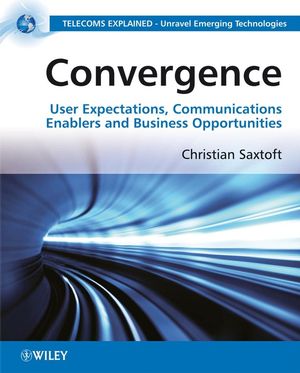|
Textbook
Convergence: User Expectations, Communications Enablers and Business OpportunitiesISBN: 978-0-470-72708-9
Paperback
250 pages
May 2008, ©2008
 |
||||||
List of Abbreviations.
PART I: EXPERIENCE OF THE END-USER.
Chapter 1: Communications in a User Perspective.
1.1 History of the Communications Services Users.
1.2 The ‘Long Tail’.
1.3 A Fragmented User Community.
1.4 Knowledge: A Human Resource.
1.5 Summary.
1.6 References.
Chapter 2: The Convergence Culture Square.
2.1 Different Dimensions to Convergence.
2.2 Social Changes.
2.2.1 Consumer Production.
2.2.2 A Participatory Culture.
2.3 Convergence in Thinking.
2.4 Change Management Challenges.
2.5 Value Perception.
2.5.1 Management of User Expectations.
2.5.2 Terminal-Based Services.
2.6 Summary.
2.7 References.
PART II: CONVERGENT BUSINESS MODELS.
Chapter 3: Market Trends and Predictions.
3.1 Towards End-User Focus.
3.2 Changing Patterns in the Communications Industry.
3.2.1 Classification of CSPs.
3.2.2 User Behaviour.
3.3 Important Market Characteristics.
3.4 Value Systems in the Communications Industry.
3.4.1 Sustainable Competitive Advantage.
3.4.2 Brand Value.
3.4.3 Psychological Factors that Influence Consumers.
3.4.4 End-User Influence on the Value System.
3.5 Value Grid in the Communications Industry.
3.6 Summary.
3.7 References.
Chapter 4: Structures and Strategies.
4.1 The Competitive Environment.
4.2 Diminishing Control.
4.3 Web 2.0-Driven Business Models.
4.4 The Sphere of Influence.
4.5 User Expectations.
4.6 Advertising.
4.6.1 Contents-Sensitive Advertising.
4.6.2 User Privacy Versus User Benefits.
4.6.3 Respect for the User.
4.7 Summary.
4.8 References.
Chapter 5: Strategic Opportunities.
5.1 Generic Business Strategies.
5.2 Quality Versus Cost: A Trade-Off.
5.3 ‘Lean Operator’ and Beyond.
5.4 Summary.
5.5 References.
PART III: TECHNOLOGIES AND SERVICES.
Chapter 6: Enabling Technologies.
6.1 Core Network Technologies and Systems.
6.1.1 IP Multimedia Subsystem.
6.1.2 Service Delivery Framework.
6.2 Access Network Technologies and Systems.
6.2.1 Fixed-Line Access.
6.2.2 Wireless Access.
6.3 Consumer Products.
6.3.1 Mobile Terminal Evolution.
6.3.2 Home Entertainment Hub.
6.4 Summary.
6.5 References.
Chapter 7: Convergent Services and Systems.
7.1 Services on Mobile Terminals.
7.2 Television and Video Services.
7.2.1 IPTV.
7.2.2 Internet Video.
7.2.3 Mobile TV.
7.2.4 Digital TV Broadcasting.
7.3 Other Convergent Services.
7.3.1 Music Downloading.
7.3.2 Radio Listening.
7.4 Fixed-Mobile Convergence.
7.5 Summary.
7.6 References.
PART IV: BUSINESS PROCESSES IN CONVERGENT COMMUNICATIONS MARKETS.
Chapter 8: Management of Convergent Services.
8.1 Enterprise Software Environment.
8.1.1 Customer Relationship Management.
8.1.2 Enterprise Resource Planning.
8.1.3 Operations Support Systems.
8.1.4 Business Support Systems.
8.2 Enterprise System Integration Challenges.
8.2.1 Enterprise Architecture Frameworks.
8.2.2 Service-Oriented Architecture.
8.3 Enterprise Process Optimization.
8.3.1 Telecommunications Process Framework.
8.3.2 IT Process Framework.
8.3.3 Cross-network Optimization Challenges.
8.3.4 Process Mapping.
8.3.5 Simplified Process Loops.
8.4 Methodologies for Business Process Optimization.
8.4.1 Business Process Management.
8.4.2 BPM Automation.
8.5 Summary.
8.6 References.
Chapter 9: New Business Opportunities.
9.1 The Network – a Managed Dynamic Business Asset.
9.1.1 Business Opportunity Management.
9.1.2 A Business Management Paradigm Shift.
9.1.3 Business Data Requirements.
9.2 Knowledge Based Organisations.
9.2.1 Scarcity of Network Capacity.
9.2.2 Scarcity of Service Innovation.
9.2.3 Scarcity of Customer Attention.
9.2.4 Scarcity of Business Evolution.
9.3 Opportunities in Outsourcing.
9.4 Summary.
9.5 References.
Chapter 10: Management of User Expectations.
10.1 Mobile Terminals and Convergence of Services.
10.2 Control of End-User QoE.
10.3 Terminal Characteristics and User Preferences.
10.4 CSP Crossroads.
10.5 Summary.
10.6 References.
Chapter 11: Billing and Convergent Charging.
11.1 Convergent Charging System Architecture.
11.1.1 Hybrid Tariffs.
11.1.2 Mobile Payment.
11.2 Standardized Charging and Billing Frameworks.
11.3 Data Sources in Charging and Billing Systems.
11.3.1 Charging Data.
11.3.2 Billing Data.
11.4 Summary.
11.5 References.
PART V: CONVERGENCE AND BEYOND.
Chapter 12: Innovation and New Opportunities.
12.1 Categories of Innovation.
12.1.1 Scope of Innovation Processes.
12.1.2 Depth of Innovation Processes.
12.2 Methods to Facilitate Innovation.
12.2.1 Execution Processes.
12.2.2 Creativity Processes.
12.3 Innovation Frameworks.
12.3.1 Theory of Inventive Problem Solving.
12.3.2 Organizational Challenges.
12.4 Convergence of Experience.
12.4.1 Human Interfaces.
12.4.2 Social Networking.
12.5 Future Trends.
12.5.1 Beyond Web 2.0.
12.5.2 Crossing the Line.
12.6 Summary.
12.7 References.
Chapter 13: The Future of Communications.
13.1 A Different Paradigm.
13.1.1 Changes to the Value Chain.
13.1.2 Convergence Culture.
13.2 The New Challenges.
13.2.1 The Competence Trap.
13.2.2 Eight Primary Challenges and Opportunities.
13.2.3 Overview of Challenges and Opportunities.
13.3 The New Horizons.
13.4 Summary.
13.5 References.
Index.



